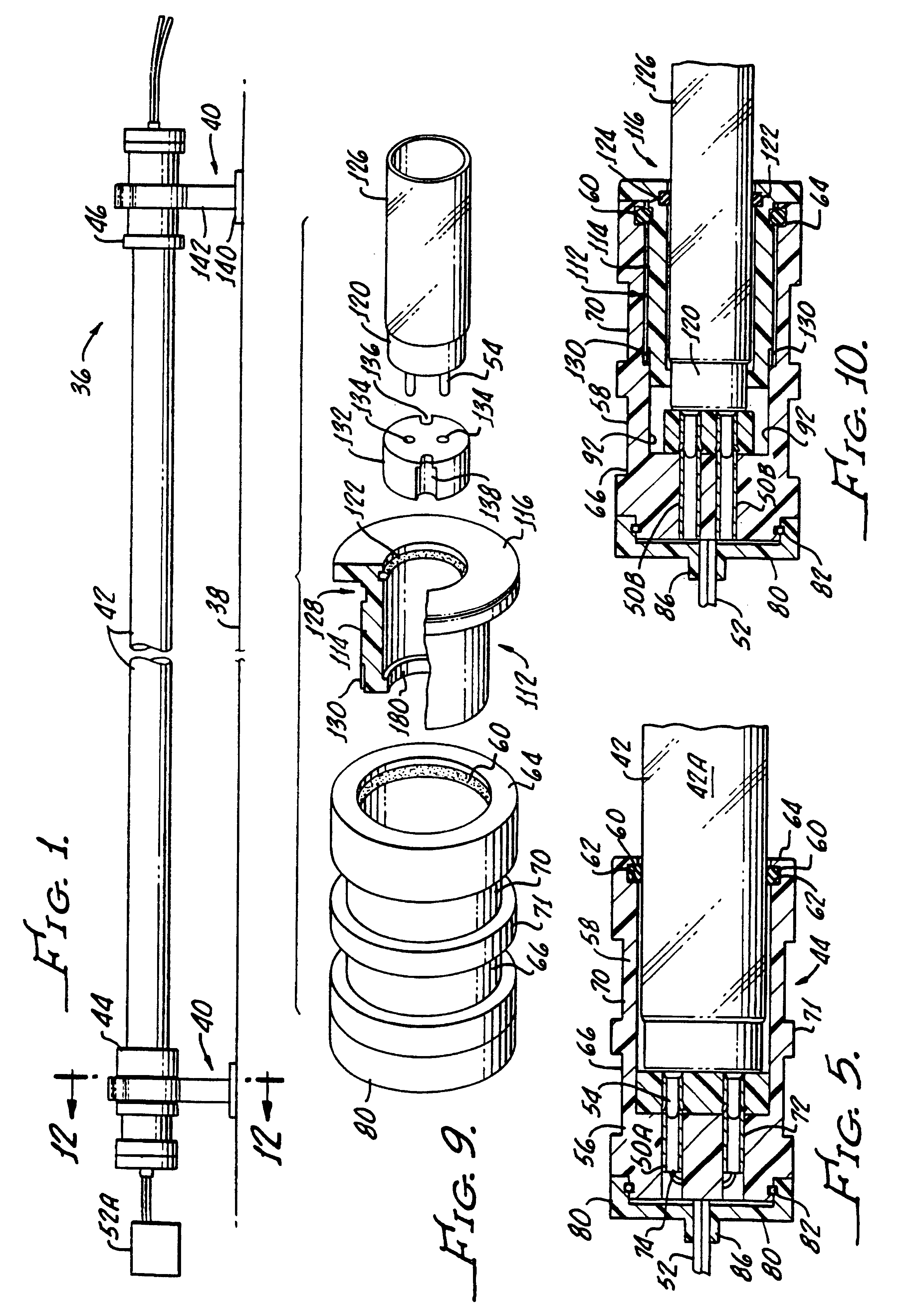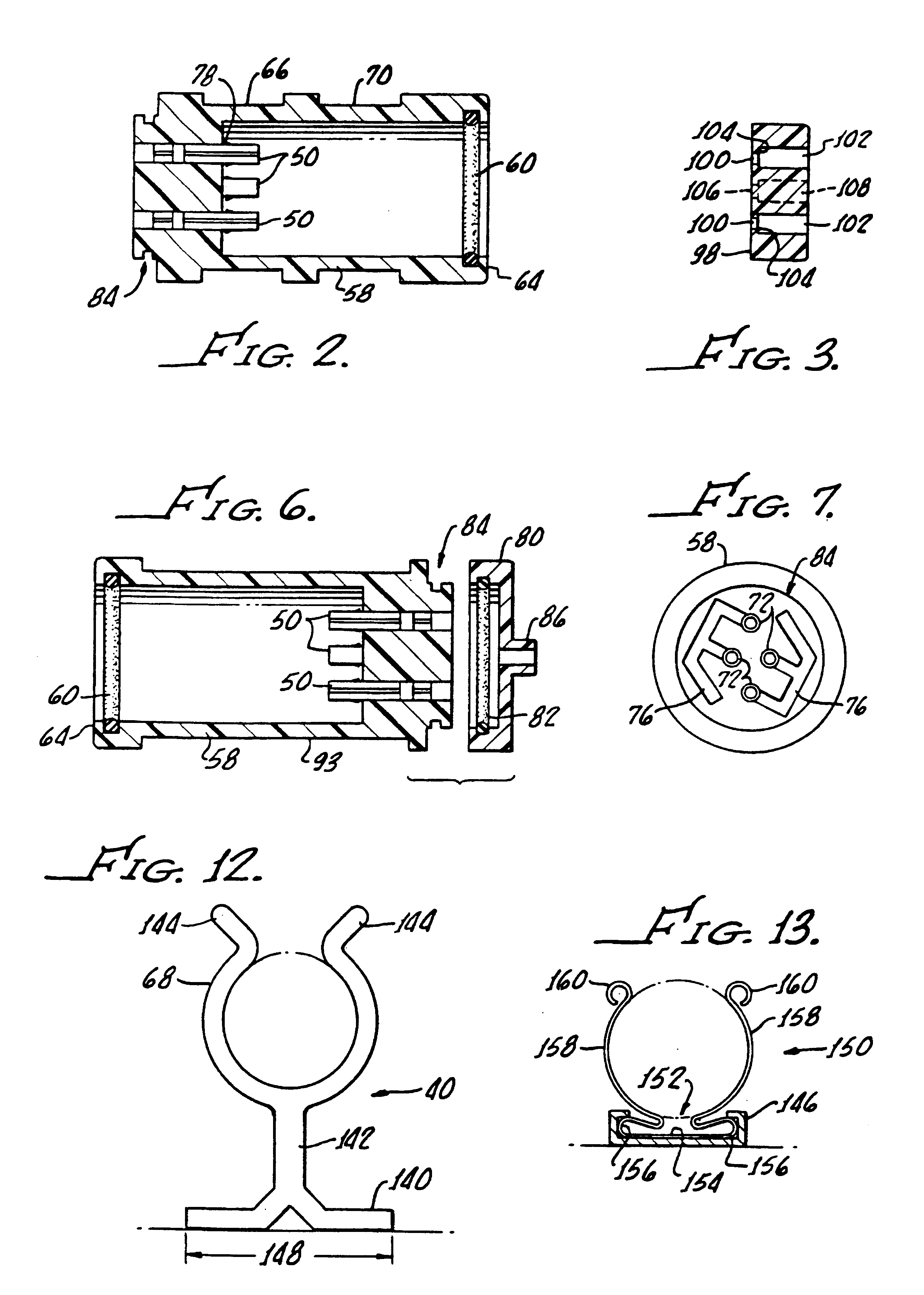For example, most household incandescent bulbs have the hot and neutral contacts positioned relatively close to each other and installation of the
bulb does not produce an exposed live contact.
Occasionally, the lamp is driven at a higher current in order to enhance the light output, but such overdriving of the lamp typically results in a shorter lamp lifetime.
For example, an improperly connected lamp in its respective sockets could lead to a high
open circuit voltage, which in turn could cause arcing, over-heating, possible lamp failure and possible
ballast failure.
A shock could result from a live free lamp end.
As a result, any
high current through the lamp results in a relatively higher
current density at the pins, that the socket may not have been designed for.
However, nothing prevents the free end of the lamp from being live and a potential for
electric shock.
While this socket configuration may account for expansion and contraction due to thermal
cycling and extreme environmental conditions, the potential for
electric shock remains.
Bulb size also affects the safety and
efficacy of lighting systems.
Consequently, overheating or other effects may occur.
In other fixtures where the sockets are mounted to a plastic substrate, portions of the plastic may flex or bend, permitting the socket to bend toward or away from the lamp, also possibly reducing the contact surface area between the socket and the lamp pins.
Separation or disconnection of the lamp from the socket could cause arcing, overheating, or possible
electric shock.
Contaminants and
moisture from cleaning or from use or maintenance may foul or corrode the connection and
moisture may condense or freeze on the contacts of the connection.
Additionally,
cold air around the
electrode area of the lamp will decrease the operating efficiency of the lamp, as well as possibly shorten the life of the lamp.
Environmental conditions affect the operation of lighting systems, for example, by decreasing operating efficiency, exposing the fixture to
moisture, and extreme temperatures.
Therefore, expansion and contraction may cause
lighting system failure in many applications.
Fixed center socket systems or spring-loaded socket systems often do not accommodate such changes in socket center-to-center distances caused by expansion and contraction of the substrate to which they are mounted.
Temperature extremes affect the operation of the lamp by decreasing the operating efficiency.
Significant deviations from that temperature significantly decrease the efficiency of operation and output of the lamp.
Higher temperatures may also contribute to overheating of the connection between the socket and the lamp.
High humidity may subject the lamp-socket connection to condensation of moisture around the connection, and possibly
icing about the lamp-socket connection.
Consequently, the possibility of arcing or shorting may be increased.
Increased moisture around the socket and lamp may also corrode the
metal of the lamp-socket contacts, affecting the integrity of the connection between the lamp and the socket, for example by increasing the resistance in the connection, causing arcing which in turn may cause more
corrosion or oxidation.
Vibration may cause the lamp and socket to disconnect, which also may cause premature lamp or ballast failure.
Often, ballasts will fail immediately upon disconnection.
Disconnection may also cause overheating, arcing, or more serious damage.
Vibration is often caused by wind, nearby operation of motors or compressors,
impact, such as by maintenance crews, earthquake and, in the case of
refrigeration units, slamming
doors, restocking of shelves, and
heavy traffic.
Vibration may cause vibration or rotation of the lamp in a socket, leading to disconnection, especially where there is nothing that inhibits disconnection.
During the manufacture of lighting fixtures, the sockets are not always accurately positioned to ensure optimum connection of the lamp pins and the sockets.
For example, on tombstone-style sockets, fixedly mounting the socket on the substrate several sixteenths or an eighth of an inch too close together or too far apart could lead to an
improper connection.
If the sockets are too close together, installing the lamps between the sockets will force one or both sockets to bend away from the lamp.
Bending could cause either a poor connection or an incomplete connection with the lamp, especially where there is nothing in the tombstone socket design that inhibits disconnection in a direction longitudinally of the lamp.
If one socket has a good connection, but the other socket has a poor connection or no connection at all, the affected lamp end will be live and subject to arcing or overheating and possible damage or injury.
Thereafter, replacement of lamps would result in further loosening of the sockets and possible failure of the fixture.
In addition to sockets not always being properly positioned or spaced, an inadequate or failed connection can result where lamp lengths vary from one lamp to the next, or between lots.
Shorter lamps may lead to inadequate connection.
Poor socket-lamp connection can also result from poor contact alignment on lamps.
However, if the pin alignment of one pair is not identical to the pin alignment of the pair of pins on the opposite end of the lamp, an incomplete connection may result at one end or the other of the lamp.
Failure to contact, or an incomplete contact may result in possible failure of the fixture.
Repair or replacement of lighting fixtures is often difficult in cases where the sockets are fixedly mounted to a substrate.
Often, the substrate is not designed for easy removal and replacement of lighting sockets, further exacerbating any connection problems that might occur between lamps and sockets.
Loose or bent sockets increase the likelihood of connection failure.
Similar problems could arise during cleaning or maintenance of the equipment surrounding the lighting fixture.
For example, in
refrigeration units, the lamp fixture could be jarred or jammed during cleaning, restocking of shelves or at other times. Additionally, sockets may be jarred or damaged when they are first installed in the support structure, when lamps are first installed in the fixture, or when lamps are removed and replaced.
In these circumstances, it is possible that the connection between the socket and the lamp is no longer adequate, resulting in or leading to inadequate or incomplete connection or a failed connection.
It is also believed that inadequate connection and reduced
conductivity in the lighting circuit may lead to lighting inefficiencies and possible ballast failure even before complete failure of an
electrical connection, such as failure of the connection between the lamp and its socket.
Therefore, differences (or variances)in the lighting circuit from the optimum design will also affect the ballast and ballast operation, in addition to affecting the other components of the circuit.
For example, differences may arise such as through an inadequate lamp connection resulting from an oversized lamp, improper socket placement, socket damage during installation, as well as other reasons.
Lower
conductivity, as well as other differences or changes in the circuit from the optimum design, may lead to ballast overheating, as well as overheating of other circuit components, and possibly ballast or other
circuit failure.
However, newer T8 and T5 lamps are not interchangeable with T10 and T12 lamps, nor with each other.
Therefore, interchangeability of sockets is made more difficult and interchangeability of lamp sizes for a given socket arrangement is not available.
Consequently, the drawbacks discussed previously relating to replacement of sockets apply equally to interchanging one socket size or type for another.
Some of those fixtures may have marginal lamp pin-to-pin socket terminal connections that may cause premature lamp failure, ballast
burnout, and the like.
Additionally, differences in lamp length between T8 and T5 lamps make conventional fixtures difficult to use and precluding interchangeability of lamps with having to replace fixtures.
 Login to View More
Login to View More  Login to View More
Login to View More 


